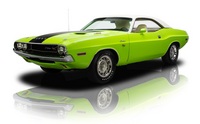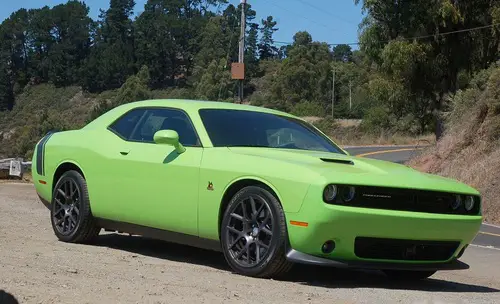Dodge Challenger Tutorial Includes 2015 Dodge Challenger R/T Scat Pack Review +VIDEO
The 2015 Dodge Challenger R/T Scat Pack surpasses its legendary ancestors in every way
DRIVING DOWN THE ROAD
WITH CAREY RUSS
The bright "Sublime" green 2015 Dodge Challenger R/T Scat Pack sitting outside at the moment could be mistaken for an exercise in nostalgia. It looks nearly identical to its ancestor from 1970, right down to the unmistakable near-psychedelic color and black tail stripe. So yes, there is a definite appeal to the past -- but this is a contemporary car, and far, far better than either the myth or the reality of the muscle car glory days.
 1970 Challenger - RK Motors |
Unusually, the chassis was a unibody, not body-on-frame. Suspension was standard for the day, independent in front and a solid axle on leaf springs in the rear. Brakes were drum, with disc available. Although some 1970 Challengers were road-raced (the 340 engine was de-stroked to the 305ci/5.0-liter limit for the SCCA Trans-Am series), drag racing was a more common competition habitat.
The current Challenger made its debut in 2008, visually evocative of its ancestor but larger in every dimension. The Hemi was back, although this one shares only the name with the original. A variety of V6 and V8 engines have been offered since then, with today's choices being the 3.6-liter (220CID), 305-hp Pentastar V6, the 5.7-liter (345CID), 372-hp Hemi, and the 6.4-liter (392) SRT Hemi, 485 hp and 475 lb-ft at your service. Unlike the days of yore, with three- or four-speed sticks and three-speed automatic the transmission choices, we now get an eight-speed automatic, in two forms, one for the V6 and a heavy-duty version for the V8s, with a six-speed stick to be offered for the V8s.
The engine is in the front, driving the rear wheels, but don't expect a solid axle. Suspension is fully-independent, and even the V6's base-model tires are likely far better than anything available in 1970.
Despite its 485 hp and 475 lb-ft, the Sublime Beast was surprisingly civilized and comfortable. Delicate throttle control was a necessity, especially at low speeds and on loose surfaces, but it could be driven in a reasonable manner, and even in stop-and-go traffic. If I'd had a suitable location to do 0-60 (or however higher as top speed is reputed to be 180 mph / 300 kph) runs without attracting undue attention, electronic goodness in the form of traction control and launch control could save the rear tires. Handling? Need track time to get anywhere near even halfway to its limits. Brakes? No one-use drums here, ventilated and slotted discs all around, gripped by four-piston Brembo calipers thank you very much. Antilock of course, and all of the contemporary traction amenities. Yes, at nearly $50,000 as equipped, this is not an inexpensive car. It's a factory tuner car in the manner of Mercedes-Benz's AMG and BMW's M, with an American accent. Other than looks and name, it is in no way a one-dimensional dragstrip special, as was the case with most 60s muscle cars. It should be happier at a track day than in the daily commute, but will work admirably for either.
APPEARANCE: Dodge never made any secret that today's Challenger is a tribute to the original, 1970 and 71 in particular. Emphasizing that, the 2015 grille gets twin rectangular insets in its grill -- it's 1971 all over again! The standard hood is a near-replica of that of the original, and later in the model year the Shaker makes a comeback -- that's an airbox attached to the engine that protrudes through the hood. And shakes with the engine‚€¶ Furthering the retro look are colors and striping patterns. In Sublime -- near-fluorescent light green -- this is a hard car to miss. The low front splitter does demand care in parking.
COMFORT: Yes, the exhaust rumbles. Properly. And although there is a definite air of menace (especially to your driving record) and power about the car, it's actually quite comfortable and civilized inside. Styling cues may evoke 1971 but the materials used and seat comfort are far ahead of that. "Manual" was the operative word then for windows, mirrors, seats, and doorlocks. "Power" is now for all of those, plus steering wheel adjustment for both tilt and reach. Leather covers the seats, and side bolstering is unobtrusive but adequate. Front seats are both heated and ventilated. Interior materials and fit and finish are of high quality. Climate control is far beyond what was available 45 years ago. And then there are the electronics‚€¶ In 1970, having FM in the radio was exotic. Beyond that, maybe a cassette tape player or 8-track. (If you don't know what an 8-track was, be glad) Here it's AM, FM, Sirius/XM for radio, jack, USB, and SD card for more, plus Bluetooth connections. No need to find Wolfman Jack talking at ya from XERB, audible throughout the galaxy‚€¶ Or to listen to updates by Super Soul. And then there are the on-board performance recorders. Want to know how much horsepower the engine's making? Time your 0-60, 0-100, or 1/8 mile? Or your reaction times? This can tell you. Just be sure the information doesn't fall into the wrong hands. NASA barely had that sort of stuff in 1970.
SAFETY: No nostalgia here -- the 2015 Challenger has all of the required and expected safety features plus excellent acceleration, deceleration, and handling abilities to allow a driver to avoid incidents. Mere operators need not apply‚€¶ There are also systems including Forward Collision Warning, adaptive cruise control, Blind-Spot Monitoring with Cross-Traffic Alert, Brake Assist, a Brake-Lock Differential system to help in low-traction situations, and ParkSense and the ParkView backup camera to help when parking or backing out.
RIDE AND HANDLING: Old muscle cars had more engine than chassis. This new one is very well balanced, and can corner and stop as well as it goes. Tire technology has come a long way since 1970, and the Goodyear Eagle F1s here are better than the best racing tires then, and should last longer. At 245/45ZR20, be glad there is power steering. It's electrically-assisted, which should put lie to any statement that electric power steering is numb and non-communicative. Bilstein shocks are matched correctly to the springs and bushings for surprising ride comfort (for the genre) and excellent stick. The fully-independent short-and-long arm / multilink suspension is far ahead of 1970's double A-arms and solid axle, shod with bias-ply death tires. When it comes time to stop, no worries. Four big ventilated and slotted discs are each grasped by a four-piston Brembo caliper. This beast might have more chassis than engine -- and it has quite an engine.
PERFORMANCE: The old 1950s-60s Hemi lives on -- in highly modified form in NHRA dragsters. The new Hemi really only shares the name. And although it's allegedly low-tech, with a cast-iron block and two pushrod-actuated valves per cylinder, iron is strong, and doesn't have to be overly heavy if designed and constructed correctly. Cross-bolted main bearings ensure a strong bottom end. Roller tappets make it compatible with modern low-viscosity, low-zinc oils to reduce emissions and fuel consumption. Maximum horsepower is 485 at 6000 rpm, with torque peaking at 474 lb-ft at 4200 rpm, but there is plenty of grunt from idle on. Enough so that I was only occasionally tempted to use the shift paddles to change gears in the new eight-speed automatic transmission. With 475 lb-ft, who needs a transmission? High high gears and low lows with minimal rpm drops between are the key to combining power and economy. In D at 70mph (not even the fast lane around here) the engine is turning less than 2000 rpm. Redline is 6400. It growls down low and howls as revs increase. Is that red-shift in the rear-view mirror or did I just get lit up? Traction control and launch control help keep things more or less civilized, but it's never completely there, and all the better for that. Fuel economy? Not a reason to buy this, but with mostly normal driving and continuous balks from the Anti-Destination League, 16.6 mpg for the week. If I was really having fun, I'd expect ten less. And if 485 horsepower doesn't quite do it for you, there's the SRT Hellcat, supercharged to 707 hp, coming soon.
CONCLUSIONS: With more muscle and greater civility, the 2015 Dodge Challenger R/T Scat Pack surpasses its legendary ancestors in every way.
**reference: Muscle Car Color History: Barracuda & Challenger Paul C. Zazarine MBI Publishing, 1991
SPECIFICATIONS
2015 Dodge Challenger R/T
Base Price $ 37,495
Price As Tested $ 47,860
Engine Type 16-valve pushrod OHV V8, cast-iron
block, aluminum heads, sequential fuel
injection with fuel-saver mode
Engine Size 6.4 liters / 392 cu. in.
Horsepower 485 @ 6000 rpm
Torque (lb-ft) 475 @ 4200 rpm
Transmission 8-speed ZF automatic
Wheelbase / Length 116.2 in. / 197.9 in.
Curb Weight 4082 lbs.
Pounds Per Horsepower 8.4
Fuel Capacity 18.5 gal.
Fuel Requirement 91 octane unleaded premium gasoline.
Tires 245/45ZR20 99Y Goodyear Eagle F1
Brakes, front/rear vented and slotted disc all around,
4-piston Brembo calipers
Suspension, front/rear independent short-and-long arm /
independent multi-link
Drivetrain front engine, rear-wheel drive
PERFORMANCE
EPA Fuel Economy - miles per gallon
city / highway / observed 15 / 25 / 16
0 to 60 mph < 5.0 sec
OPTIONS AND CHARGES
Driver Convenience Group $ 995
Uconnect 8.4AN $ 695
Scat Pack Appearance Package $ 1,995
Leather Interior Group $ 1,500
Technology Group $ 995
Power Sunroof $ 1,195
Torque-Flite 8-speed automatic $ 1,400
Sound Group 2 $ 595
Destination Charge $ 995



